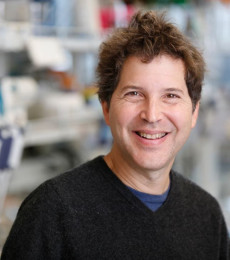David Baker Wins Nobel Prize for Chemistry
October 11, 2024
By Elizabeth Ball
Contact: cscomms@lbl.gov

David Baker has used 1.5 million GPU hours on NERSC systems and published at least eight major papers acknowledging NERSC. (Credit: UW Medicine)
David Baker, a computational biologist and professor of biochemistry, Howard Hughes Medical Institute investigator, director of the Institute for Protein Design at the University of Washington, and prolific user of the systems at the National Energy Research Scientific Computing Center (NERSC), has been awarded a Nobel Prize for Chemistry for his work in computational protein design.
Baker’s body of work centers around using computational approaches to design entirely new proteins that may solve global challenges in fields like medicine, technology, and sustainability – innovations like novel vaccines and antivirals, ways of breaking down plastics in the environment, and artificial photosynthesis. He and his team developed Rosetta, an algorithm for ab initio protein structure prediction; it has since been expanded into AI-powered tools like RoseTTAfold, which uses a three-track neural network to quickly and accurately predict protein structures based on limited information.
According to the Royal Swedish Academy, which awards the Nobel Prize, “Proteins generally consist of 20 different amino acids, which can be described as life’s building blocks. In 2003, David Baker succeeded in using these blocks to design a new protein that was unlike any other protein. Since then, his research group has produced one imaginative protein creation after another, including proteins that can be used as pharmaceuticals, vaccines, nanomaterials and tiny sensors.”
Since first accessing NERSC systems in 2021, Baker’s team has used 1.5 million GPU hours on NERSC’s Perlmutter system and published at least eight major papers acknowledging NERSC, on topics ranging from modeling protein-protein interactions that are key to biological processes to illuminating microbial “dark matter” through metagenomics. Baker and his team were among the first to use Perlmutter’s GPUs when they were installed in 2021. In June 2024, Baker described his work and the ways in which NERSC has enabled it in a seminar, part of the NERSC@50 seminar series celebrating NERSC’s 50th anniversary.
About NERSC and Berkeley Lab
The National Energy Research Scientific Computing Center (NERSC) is a U.S. Department of Energy Office of Science User Facility that serves as the primary high performance computing center for scientific research sponsored by the Office of Science. Located at Lawrence Berkeley National Laboratory, NERSC serves almost 10,000 scientists at national laboratories and universities researching a wide range of problems in climate, fusion energy, materials science, physics, chemistry, computational biology, and other disciplines. Berkeley Lab is a DOE national laboratory located in Berkeley, California. It conducts unclassified scientific research and is managed by the University of California for the U.S. Department of Energy. »Learn more about computing sciences at Berkeley Lab.







